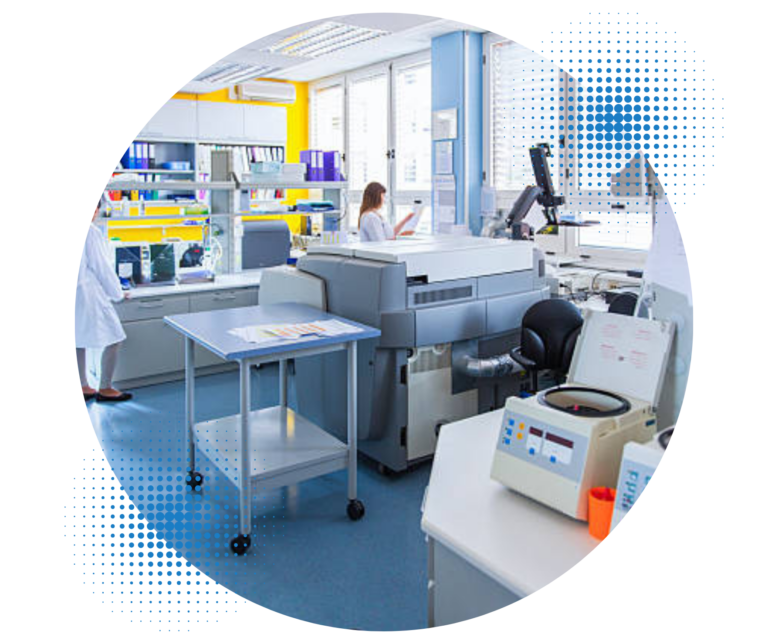Subvisible Particle Counting & Sizing
Ensuring patient safety is the topmost priority of the pharmaceutical industry, and managing subvisible particulates is crucial to fulfilling this commitment. Even though subvisible particulates are tiny, they can significantly impact patient health by causing adverse reactions such as inflammation and immune responses and compromising the drug’s efficacy. Hence, drug manufacturers must conduct comprehensive subvisible particulate testing to ensure the safety of their products for patient use.
Subvisible Particulate Matter in Therapeutic Protein Injections with USP 787
This chapter offers an alternative to the USP general chapter Particulate Matter in Injections 788. It focuses on therapeutic protein injections and related preparations. The chapter allows smaller test product volumes and smaller test aliquots to determine particulate matter content. Additionally, it provides sample-handling instructions that consider the issues associated with analyzing these materials. While the methodology and limits presented in this chapter are preferred for therapeutic protein injections, using regulatory-acceptable alternative analytical methods with adequately developed subvisible particulate limits is also acceptable.

Ensuring Injection Safety with USP 788
Subvisible particulate testing is a crucial aspect of drug development and manufacturing. Its purpose is to detect and measure particles in pharmaceutical formulations that are too tiny to be seen by the naked eye, but could still pose a threat. Specialized instruments and techniques such as light obscuration and light microscopy. and micro-flow imaging are usually used in subvisible particulate testing. By conducting these tests, manufacturers can ensure that their products comply with regulatory requirements and are safe for patient use. Additionally, these tests can help manufacturers identify potential issues with their manufacturing processes or formulation, enabling them to make necessary adjustments and enhance their products.

Particulate Matter in Ophthalmic Solutions with USP 789
Particulate matter refers to tiny and diverse substances that cannot be measured through chemical analysis because of their small quantity and heterogeneous composition. They are not gas bubbles, but mobile, randomly sourced extraneous substances. In ophthalmic solutions, there should be no visible particles. To ensure this, physical tests are conducted to count the number of extraneous particles within certain size ranges.

JP 6.07 Insoluble Particulate Matter Test for Injections
The Japanese Pharmacopeia Chapter 6.07 is harmonized with the European Pharmacopeia and the United States Pharmacopeia on the matter of testing for subvisible particulates in injections and infusions. In JP 6.07, two methods are cited to perform this testing: light obscuration analysis and microscopic particle counting. JP 6.07 prefers the use of a light obscuration counter, except when light obscuration is demonstrated to be insufficient to perform the testing. In this case, the microscopic particle count test is used. These instruments are widely used to test small-volume and large-volume parenteral infusions/injectables.
mobile, randomly sourced extraneous substances. In ophthalmic solutions, there should be no visible particles. To ensure this, physical tests are conducted to count the number of extraneous particles within certain size ranges.

Ph. Eur. 2.9.19 Particulate Contamination: Sub-Visible Particles
The European Pharmacopeia Chapter 2.9.19, along with the United States Pharmacopeia Chapters 788 and 787 apply to most small- and large-volume parenteral products. These products include ready-to-use solutions for intramuscular, subcutaneous, or intravenous (IV) injection.
EP 2.9.19 defines particulate contamination of injections and infusions as extraneous, mobile, undissolved particles, other than gas bubbles, that are unintentionally present in solutions. Two methods are cited to perform this testing: light obscuration analysis and microscopic particle counting. EP 2.9.19 is harmonized with USP 788 and 787 and prefers the use of a light obscuration counter, except when light obscuration is demonstrated to be insufficient to perform the testing. In this case, the microscopic particle count test is used. These instruments are widely used to test small-volume and large-volume parenteral infusions/injectables.

Delve into the Details, Navigate the Unseen
Don’t let subvisible particles compromise your product’s integrity. Subvisible particles are a common issue in pharmaceutical manufacturing that are difficult to detect. Drug product batches must undergo release testing for years to comply with the USP particle size specifications and limits. However, many companies are unaware of the new regulatory requirements beyond USP <788>.
Gateway Analytical: Your Partner in Precision
Elevate your product integrity with Gateway Analytical’s specialized sample storage solutions. Our cutting-edge facilities ensure optimal conditions for pharmaceutical and biotechnological samples, preserving their stability and quality. From advanced refrigeration to cryogenic storage, we safeguard your critical research, ensuring every sample’s potential is realized. Trust us to maintain the perfect environment for your valuable assets, backed by meticulous monitoring and documentation for unparalleled traceability


